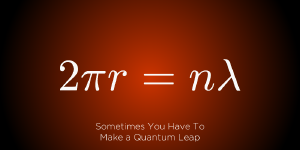Post
Step by Step
9 July 2013
 Brian Koberlein
Brian KoberleinIn the 1860s James Clerk Maxwell published a set of elegant and beautifully subtle equations now known as Maxwell’s equations. Maxwell’s equations describe charges and magnets not by the forces between them, but by their fields of electricity and magnetism. Thus, a charge is surrounded by a field of electricity, a field that other charges can detect. Charges possess electric fields, and charges interact with the electric fields of other charges. Likewise, magnets possess magnetic fields, and interact with magnetic fields.
This was a radically new way of looking at things, but with that change of view Maxwell demonstrated that electricity and magnetism were connected by their fields. A moving electric field creates a magnetic field, and a moving magnetic field creates an electric field. Not only are the two connected, but one type of field can create the other. Maxwell had created a single, unified description of electricity and magnetism. He had united two different forces into a single unified force, which we now call electromagnetism.
In the late 1800s J. J. Thompson had discovered the electron, and in the early 1900s Ernest Rutherford demonstrated that atoms consisted of a dense nucleus surrounded by electrons. This led Rutherford to suppose that atoms behaved similar to the solar system. Just as the massive Sun lies at the center of the solar system, with the lighter planets orbiting the Sun, the massive nucleus lies at the center of the atom, with the lighter electrons orbiting it.
But according to Maxwell’s theory this couldn’t possibly be true. If an electron orbited the nucleus, its motion would create electromagnetic waves (light). Those waves would carry energy away from the electron, causing the electron to spiral into the nucleus. Within a fraction of a second an atom would collapse in a flash of light. There seemed no way out of this conundrum. Experiments proved that electrons were particles. They proved that atoms had a nucleus. They proved that moving charges created electromagnetic waves. How then was it possible for atoms to exist?
The initial solution came from Niels Bohr. Bohr knew that atomic gases do not emit a continuous range of colors when heated. Instead they emit only particular colors. The colors they emit are known as spectral lines. Each type of atom or molecule emits a unique pattern of spectral lines, and serves as a kind of fingerprint. By observing the spectral lines of stars, for example, we can identify the elements that make up those stars. The measurement and analysis of spectral lines from stars, nebulae and galaxies has long been a useful tool in astronomy.
Bohr proposed that somehow electrons don’t radiate energy as they orbit the nucleus. Instead the have specific orbits. Rather than continuously radiating energy, electrons would only emit energy when they jumped from a larger orbit to a smaller orbit. Likewise electrons could absorb energy to jump from a smaller to a larger orbit. In other words, the orbits of electrons were quantized, and electrons must make a quantum leap to move from one orbit to another.
This model explained why atomic gases only emitted certain colors of light when heated. Because electrons could only move from discrete orbit to discrete orbit, they could only emit specific wavelengths of light. Bohr demonstrated that his model agreed perfectly with the colors emitted by hydrogen atoms, thus proving that electrons had discrete orbits. While Bohr’s atomic model made atoms possible once again, there was no clear reason why electron orbits were discrete. Why should electrons follow a different set of rules in an atom than they did when they were free?
The answer came from Louis de Broglie. He proposed that electrons were not simple particles like billiard balls. Instead, they have a wave-like property to them. Just as light is an electromagnetic wave, electrons were matter waves. De Broglie proposed that the wavelength of an electron depended on its momentum (a product of its mass and speed). If this were true, then rather than orbiting the nucleus, the electron wave wrapped around the nucleus. This meant that the orbit of an electron could only be an integer number of wavelengths.
This is summarized in the equation below. Here the left side of the equation is the circumference of the circular orbit, lambda (looking like an inverted y) is the wavelength of the electron’s matter wave, and n is an integer (1, 2, 3, etc.). This agrees perfectly with Bohr’s atomic model. Atomic electrons have quantized orbits because they are matter waves.
But this model raised more questions than it answered. Thompson’s experiment proved that electrons are particles, not waves. Now de Broglie demonstrates that they are waves, not particles. It seems then that electrons have some type of strange particle-wave duality. This violates the basic tenets of Newtonian physics. The mechanics of Newton’s laws must not apply to electrons. They must follow a different set of rules involving matter waves and quantized orbits. What, then, are the laws of these quantum mechanics?
This new quantum theory was revealing itself, step by step.
Tomorrow: An ultraviolet catastrophe leads to the discovery of the fundamental constant of quantum theory. It is a constant that will take us from the tiniest particles to the edge of the universe. The universe in a nutshell, next time.